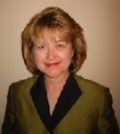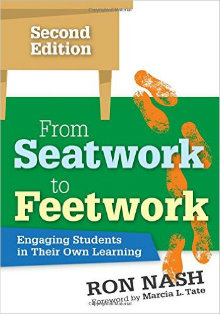Engaging Students: From Seatwork to Feetwork
From Seatwork to Feetwork: Engaging Students in Their Own Learning, Second Edition
By Ron Nash
(Corwin, 2016 – Learn more)

Meet Ed. He’s taught high school for 27 years, nineteen of them U.S. history. At the request of his administrator, Ed visits another history teacher with high standardized test scores at a different school. Not only are the seating arrangements different from Ed’s traditional classroom, but the students are doing more work and talking more than the teacher.
They are active, not passive learners. They take risks, make mistakes, discuss, research, work in pairs and groups and have a good relationship with their teacher. His visit and observations cause Ed to “look in the mirror.”

Nash contends that if every educator commits to changing their way of doing things to promote active learning, then our students will be all right, and standardized testing will show it.
The teacher as facilitator
First, the teacher needs to become a facilitator, not the “chief information officer.” We need to throw out the lecture approach and multiple choice tests and even bell to bell instruction. We need to cover less rather than more material, but in depth. Good questions need to be asked, and students need to be allowed to explore electronically.
The author recommends well-developed checklists and rubrics so students can monitor their own learning. He even wants students to “help plan the journey.” Less homework is advised, and what homework is assigned should be meaningful, like reading and writing in journals or researching or interacting on the computer. Either “fight the technology or use it,” Nash says.
We need to move around more
The author devotes an entire chapter to the connection between exercise and learning. There are fewer Physical Education classes required these days, and kids are spending more time indoors, sitting, largely as a result of standardized testing and our thinking that we all need to “hunker down.”
But students who are physically fit perform better, and research bears this out. Long sitting periods may be rougher on boys than on girls. Could this be why we’re seeing more ADHD children? “Kids gotta move.” Nash gives examples of many “burst-of-energy” activities, some with music.
The power of collaboration
Nash points out that if we are to teach students perspective and empathy, we also need to teach them how to listen. Instead of focusing on competition, Nash prefers collaboration. Teachers should try to help students achieve their personal best, but also students often enjoy charting the performance of the class as a whole.
Again he cites research that says that working cooperatively with peers “may be the most critical social skill that students learn when one considers the importance of cooperation in the workplace, in the family, and in leisure activities.” Teaching kids how to collaborate now will even improve the future workplace.
Nash is honest and recalls his early years of teaching when he taught compliance more than thinking and learning. None of the skills mentioned in the book are developed in a completely non-compliant environment, however. Structures need to be put into place, preferably in the first five weeks of school. Routines should be established the first week, and he gives teachers two good phrases from behavior expert Fred Jones: “I say what I mean, and I mean what I say,” and “We are going to keep doing this until we get it right.”
To have students work harder than the teacher, there is the need for “frontloading.” Nash talks about teacher preparation to put systems into place for transitioning, teaching listening, and preparing work for the students to do. He praises one teacher for writing paragraphs with mistakes for students to correct. But why not use student writing?
I also would use ten-minute lectures. After all, students may encounter the lecture format when they go on to college since most professors are not trained in these more innovative strategies and are expected to be expert in their fields. Students can practice note-taking skills during these short lectures.
Effective feedback
Nash says feedback “should be task and goal-oriented.” Goals need to be challenging and feedback immediate. This applies to administrator feedback with teachers after an observation, too. He warns that we should not be obsessed with “rightanswermania” and suggests that in the first days of school students discuss the question, “How can mistakes be part of the improvement process?”
The purpose of feedback, the author contends, is that “acknowledging errors allows for opportunities.” The culture has to be safe for students to seek feedback. He describes the “three before me” strategy, and offers some cautions about student feedback. Praise, he believes, needs to be specific (rather than “Good job!”) and is often more effective when done in private. Nash also describes how “Process Praise” can be a motivator and warns that teachers need to wander around when students interact and never sit behind their desks. His section on how teachers can make feedback a two-way street is very valuable.
Change at the classroom level
At the end of the book, we meet Ed again. He wants to move his classroom from teacher-centered to learner-centered where students do eighty percent of the work. As Nash points out, “effective change happens at the classroom level,” although administrators need to “model collaboration” as well.
Much of what Nash writes about was begun when Cooperative Learning and Literature Circles were in vogue. But with “testing frenzy,” many schools dropped these strategies and returned to the status quo. We can’t allow that to happen again, particularly if we want our students to become life-long learners. Learning needs to become continuous and stay that way. Ron Nash’s book is an excellent place to start.
______________
Dr. Mary Langer Thompson is the author of Poems in Water, her first collection of poetry. She is a retired school principal and English teacher who still teaches poetry and writing workshops in schools and loves to use “hands-on,” collaborative activities.






























